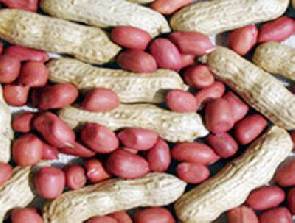Groundnuts
He made the disclosure at Navrongo in the Upper East Region to climax a three-month training programme for export-oriented chain operators, namely local producers, processors, traders and exporters.
The objective of the training programme was to reduce the level of aflatoxin contamination in groundnut, peanut butter and cereal products to meet EU technical regulations and standards.
Mr Normeshie emphasised that viewing the huge export potentials of groundnuts, there was the need for government, private sector and NGOs to invest the needed resources in the sector so as to help reduce poverty in Northern Ghana.
“Ghana with its favourable climatic conditions and abundant rich soil has a comparative and competitive advantage in groundnuts and cereal exports and, hence, is well positioned to take advantage of the international market opportunities to develop the sector”, he indicated.
The General Manger stated that as part of the National Export Strategy of GEPA which has a target to achieve US$ 5 billion from the non-traditional exports sector by 2019, groundnuts would be a critical contributor to achieving this export target set by the government.
He said it was against this background that his outfit with support from the European Union, through the Trade Related Assistance and Quality Enabling (TRAQUE) Programme started the training programme for groundnut farmers from Brong Ahafo, Northern, Upper West and Upper East Regions.
“The various actors along the groundnut value chain have been trained on topics such as the European Union general food law, good agricultural practices, pre-harvest operations, post-harvest operations, quality assurance and management, hazards in groundnut supply chain and processing, and utilization of groundnut.
“This aims to enhance export quality control, management and certification of groundnut and cereal products to the international markets”, the General Manager said.
The beneficiary areas in the Upper East Region are the Kassena -Nankana Municipality, Kassena –Nankana West District, Builsa South and Builsa North District and the Garu-Tempane District.
FRENCH VERSION
Il a fait la divulgation à Navrongo dans la région du nord-estpour couronner un stage de trois mois pour les opérateurs de lachaîne axée sur l’exportation, à savoir locaux producteurs,transformateurs, négociants et exportateurs.
L’objectif du programme de formation a été de réduire le niveaude contamination par les aflatoxines en arachide, beurred’arachide et produits céréaliers pour répondre aux normes etrèglements techniques de l’UE.
M. Normeshie a souligné que visualiser les potentiels énormesexportation d’arachides, il y avait la nécessité pour legouvernement, secteur privé et organisations non gouvernementales à investir les ressources nécessaires dans lesecteur afin de contribuer à réduire la pauvreté dans le nord duGhana.
« Ghana avec ses conditions climatiques favorables et l’abondantrichesse du sol dispose d’un avantage comparatif et compétitifdans les arachides et les exportations de céréales et, par conséquent, est bien placé pour tirer parti des débouchés àl’international pour développer le secteur », a-t-il indiqué.
Le directeur général a déclaré que, dans le cadre du NationalExport stratégie du GEPA qui a comme objectif d’atteindre US$ 5milliards provenant du secteur des exportations non traditionnelles en 2019, arachides serait un contributeur essentielà la réalisation de cet objectif fixé par le gouvernement.
Il a dit que c’est dans ce contexte que sa tenue avec le soutiende l’Union européenne, à travers le commerce Assistanceconnexes et de qualité permettant (TRAQUE) ont lancé leprogramme de formation pour les agriculteurs d’arachide deBrong Ahafo, du Nord, Upper West et du supérieur est.
“Les différents acteurs le long de la chaîne de valeur d’arachideont été formés sur des sujets tels que la législation alimentairegénérale de l’Union européenne, bonnes pratiques agricoles, desopérations avant la récolte, les opérations après récolte,assurance qualité et gestion des risques dans la chaîned’approvisionnement arachide et traitement et l’utilisationd’arachide.
« Cela vise à renforcer l’exportation contrôle de la qualité, degestion et de certification d’arachide et céréales produits sur lesmarchés internationaux », a déclaré le directeur général.
Les régions bénéficiaires dans la région du nord-est sont lamunicipalité de Kassena – Nankana Ouest District de Kassena-Nankana, Builsa Sud et Builsa North District et le quartier deGaru-Tempane.



